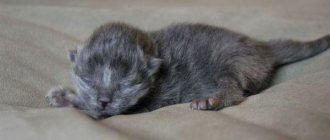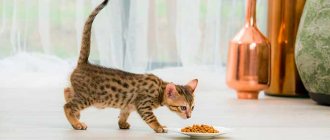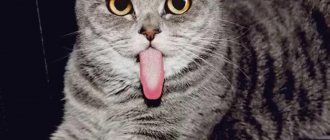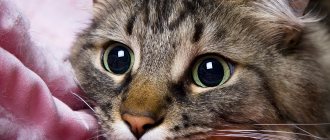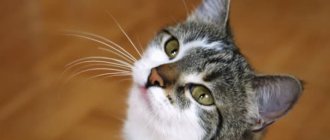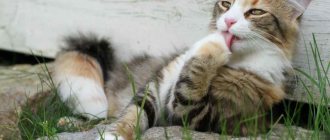Causes
Closing one eye indicates discomfort and pain. This happens for the following reasons:
- conjunctivitis;
- corneal trauma and erosion;
- inflammation of the third eyelid;
- age-related changes.
Conjunctivitis
Inflammation of the mucous membrane is not an independent disease, but a symptom of underlying diseases. The organ of vision turns red, first clear, and after 2-3 days mucous or purulent exudate flows out of it. If the cause of inflammation is injury, one eye is affected. With viral or bacterial infections, helminthic infestations, inflammation from one organ quickly spreads to another. The exception is chlamydia. For several days, one organ remains affected. This pathogen is not safe for humans.
Corneal injuries and erosions
Pain in the cornea causes the cat to squint. Most often, unilateral damage is typical for injuries received in a fight. Through a defect in the membrane, microflora penetrates into the organ and multiplies, melting the tissue. Corneal erosions are characteristic of rhinotracheitis, a viral disease of cats.
Inflammation of the third eyelid
The nictitating membrane protects the eye from debris. Normally it is invisible. However, due to injury or genetic predisposition, the third eyelid becomes inflamed and noticeable. The disease is characterized by profuse lacrimation. Over time, the exudate becomes mucous and then purulent. The discharge sticks the eyelids together and the eye stops opening. Blepharospasm develops.
Age-related changes
In old animals suffering from permanent illnesses, intraocular pressure increases. The affected organ hurts, which causes the pet to squint. If inflammation affects the choroid, one-sided blindness develops.
Contagious diseases
Damage to one eye is typical for the following infectious diseases:
- herpes;
- chlamydia;
- demodicosis;
Herpes
Blepharospasm
A viral disease better known as rhinotracheitis. An acute course is typical for unvaccinated kittens from two to three months. Chronic disease occurs in adult animals during periods of weakened immunity. At the initial stage, blepharitis develops, which is characterized by inflammation of the eyelids. They stick together and blepharospasm develops.
Subsequently, the second organ of vision is also affected. A characteristic sign of rhinotracheitis is ulcers on the cornea of the eye. Self-medication is dangerous because it can cause loss of one or both eyes, bronchopneumonia, constipation, and damage to internal organs. Treatment is prescribed by a veterinarian. To prevent rhinotracheitis, kittens and sexual partners are vaccinated before mating.
Chlamydia
The bacterial infection primarily affects kittens from 1 to 3 months. At this time, death is possible. With chlamydia, one eye first becomes inflamed, then the second is affected.
Be sure to read:
A cat’s teeth are falling out: physiological and pathological reasons, what to do, prevention
With chlamydia, one eye is affected first.
Treatment is prescribed by a veterinarian. If ophthalmic ointments or drops are used, two eyes should be treated, even though one of them looks healthy. Prevention consists of proper feeding, satisfactory living conditions and vaccination with a polyvalent drug against chlamydia and other dangerous diseases of cats.
Demodicosis
Demodicosis glasses
The pathological process is caused by the activation of the subcutaneous mite due to a weakening of the immune defense. With asymmetrical lesions, demodectic glasses are formed around one of the eyes. Soreness causes the pet to squint one eye.
Treatment consists of treating the affected surface with external insecticidal and acaricidal agents. If the pathological process goes far, inflammation occurs.
As the affected area heals, it scars and squinting becomes a lifelong cosmetic defect. Prevention consists of proper feeding, as well as applying insecto-acaricidal drops Spot on to the healthy, intact skin of the withers, which protect the pet from fleas, helminths, cutaneous and subcutaneous ticks.
What to do
When it is noticed that the cat is squinting its eye, it should be carefully examined and washed thoroughly and carefully. Use sterile gauze, but not cotton pads or swabs, to prevent lint from getting into your eyes. Independent use of eye drops containing antimicrobial agents is unacceptable. They can cause harm to health or complicate diagnosis.
If rinsing does not help, seek veterinary help. You need to protect yourself. Touching with unwashed hands can cause infection and cause conjunctivitis. Children should not be allowed to process due to the risk of contracting chlamydia. Pregnant women should not take part in the treatment of pets, because infection with Toxoplasma cannot be ruled out.
If the cat constantly squints and washing the eyes does not help, the pet should be urgently taken to the clinic. The symptom indicates a disease that is dangerous for animals and humans.
Measures to prevent eye diseases
It is easier to prevent an ophthalmic disease in an animal than to treat it. Prevention includes:
- regular vaccination;
- preventing pet hypothermia;
- examination of the animal’s visual organs after street walks;
- washing the mucous membrane and eyelids with saline solution if wounds are found on them;
- timely contact a veterinarian.
A cat squinting its eye is not necessarily due to illness. Sometimes this is a variant of the norm, for example, when the animal is sleepy or calm. It is necessary to seek veterinary help if this symptom persists for a long time and is accompanied by lacrimation, pus discharge and deterioration in the pet’s physical condition.
Causes of squinting eyes in cats
The cat's eye is an incredibly sensitive organ, so quite often it can be susceptible to inflammatory processes and the development of various pathologies. Many diseases can manifest themselves in this way when cats squint their eyes.
Let's take a closer look at the reasons for this phenomenon.:
- The presence of conjunctivitis is an inflammatory lesion of the mucous membrane of the eye. The disease is accompanied by swelling of the eyelids, mucous and purulent discharge. The affected eye becomes red and itchy, and a bluish or white cloudiness may also appear on it. To treat pathology, special eye drops are used, and rinsing procedures are also carried out. In later stages of the disease, antibiotic injections may be prescribed.
- Corneal erosion is damage to the cornea of the eye. An equally common reason why a cat squints one eye. The causes of the development of the disease are viral infections, injuries, burns, and glaucoma. Untimely treatment leads to the formation of a serious pathology - a corneal ulcer.
- Mechanical injuries to the cornea , which are always accompanied by severe pain and, as a result, the cat begins to squint its eyes. The insidiousness of such injuries lies in the penetration of pathogenic microorganisms into the depths of the tissues of the eye, where they further multiply. You should be especially careful about eye injuries caused by cat claws, since a large number of dangerous bacteria and worm eggs accumulate under them.
- An increase in eye pressure , which occurs due to age-related changes and the old age of the animal, is also a possible reason that the cat squints the visual organ. Due to the lack of proper treatment, this condition can predispose the cat to the development of one-sided blindness.
- Allergic reactions to flowers and plants , dust and household chemicals often cause a kitten to squint its eyes. A veterinarian will help identify the causative agent of the allergy and prescribe appropriate medications.
Inflammation of the third eyelid
The nictitating membrane in an active cat is invisible. The transparent membrane protects the eye sphere from dust particles and debris. Due to the inflammatory process, the membrane hypertrophies and no longer fits under the eyelids.
Most often, unilateral inflammation is observed due to the following reasons:
- infectious diseases;
- allergic reactions;
- injuries;
- internal non-communicable diseases;
- congenital predisposition.
Most often, Persians, Britons, as well as mixed breeds and cats of related breeds get sick. Treatment is surgery. To prevent inflammation of the eyelid, you should purchase a pet from trusted breeders and not engage in spontaneous selection.
Be sure to read:
Why do black spots appear in a cat’s mouth, lips, face or chin?
How to help your pet at home?
In order to provide qualified assistance to your cat, it is necessary, first of all, to know the root cause and accurate diagnosis of the disease. After all, the phenomenon in itself, when a cat squints its eye, is not considered an independent disease; it is only a consequence of hidden pathologies in the animal.
What to do if you can’t immediately visit the veterinarian’s office
- Examine your cat's eye for yourself as it squints. Make sure there are no foreign bodies in it.
- Gently but thoroughly rinse your pet's eyes with a slightly warm saline solution or regular boiled water. Use a sterile gauze swab.
- You need to collect discharge and pus very carefully, moving from the outer corner of the eye to the inner. Do not press on the eyeball under any circumstances, because the animal experiences severe pain and squints its eye to reduce it.
- It is strictly prohibited to use cotton pads during the rinsing procedure to avoid sticking of cotton fibers to the cornea of the diseased eye.
- It is strictly forbidden to use solutions of antiseptics and antibiotics for washing. This can aggravate the pet's condition and cause a burn to the cornea of the eye.
Description of possible causes
If you look at the statistics, most often when owners complain that their cat is constantly squinting one eye, injuries to the organ of vision and infectious diseases (especially in kittens) are diagnosed. Of the accompanying symptoms, great importance is given to discharge from the eyes, sudden cloudiness and redness of the whites. If any of the above symptoms appear, the following options must be excluded:
- Foreign body. It can get under the third eyelid or directly into the cornea. Plant seeds, branches from trees or bushes, glass fragments (after an accident), and food debris can act as splinters. Each blink causes discomfort and pain, which causes the cat to often squint one eye. The danger is that if the cornea is injured, there is a risk of secondary infection and the onset of an inflammatory process. It’s even worse if the pet tries to get the splinter out on its own using its paws and claws, which can significantly worsen the situation. The first thing the owner should do is wash the eyes with lotion (Opticlia, Rosinka) and try to conduct an independent examination. There are times when the splinter digs in shallowly and can be easily removed with tweezers. If the irritant cannot be detected or it has entered an inaccessible part of the eye, then it is best to seek help from an ophthalmologist. He will remove the foreign body and assess the extent of damage to the cornea and third eyelid. If necessary, prescribe anti-inflammatory drugs.
- Injury. Can happen at any age. A fight, a game, climbing trees, an accident, falling from a height - all this often ends in eye damage. If the third eyelid is injured, then for shallow scratches, antiseptic treatments for 3-7 days will be sufficient. If the cornea is injured, an examination by an ophthalmologist is necessary to assess the extent of the damage. If a cat squints one eye for more than one day after any damage, then it is better to show it to a doctor, since some processes associated with vision are irreversible if medical assistance is not provided in time.
- Corneal ulcer. The most common reason is that a cat constantly squints one eye. There is also almost always profuse lacrimation and redness of the third eyelid. Injury to the cornea can occur during play, fighting, or getting a foreign body under the eyelid. Districhiasis and trichiasis, in which the cornea is often injured, can also be the cause. The extent of the damage can be assessed only after a visual examination by an ophthalmologist and a special procedure for staining the cornea, which will show a clear location of the damage and the estimated depth. In most cases, it is possible to manage with conservative treatment using antibacterial drugs (Torbex, Tsiprovet, Floxal) and Korneregel or Solcoseryl. The healing period may take 2 to 4 weeks, depending on the size of the ulcer. If severe souring of the eye and purulent discharge occurs, it is recommended to see a doctor to rule out bacterial damage.
- Trichiasis. Congenital pathology that manifests itself in the first year of life. Due to improper growth of even one eyelash, a cat may squint one eye, as there is discomfort during blinking. In some cases, the eyelashes grow soft and do not interfere with the pet in any way, being only a cosmetic defect. But usually such eyelashes are hard and can seriously injure the cornea, so they must be removed without fail. Depending on the location and number of eyelashes, anesthesia may be used under which hair removal is performed. In severe cases, several procedures may be needed to ensure that the hair follicle atrophies and the eyelash becomes thinner and softer.
- Districhiasis. It is also considered a congenital pathology in which a double row of eyelashes is observed. Some of which necessarily injure the cornea and cause conjunctivitis and uveitis. With this diagnosis, it is mandatory to remove all abnormally growing eyelashes. If this is not done, then at first the cat will squint its eye, then lacrimation, purulent discharge and clouding will appear. Ultimately, the eye becomes swollen with a cloudy film.
Cat squinting one eye photo
There are times when it is not possible to see a doctor on the day of injury, and the animal needs first aid. Therefore, for an antibacterial effect, you can use taufon or torbex. But, remember that for a complete recovery it is necessary to assess the degree of damage (if it is an injury) or eliminate the irritating factor (if it is a foreign body or congenital pathologies).






